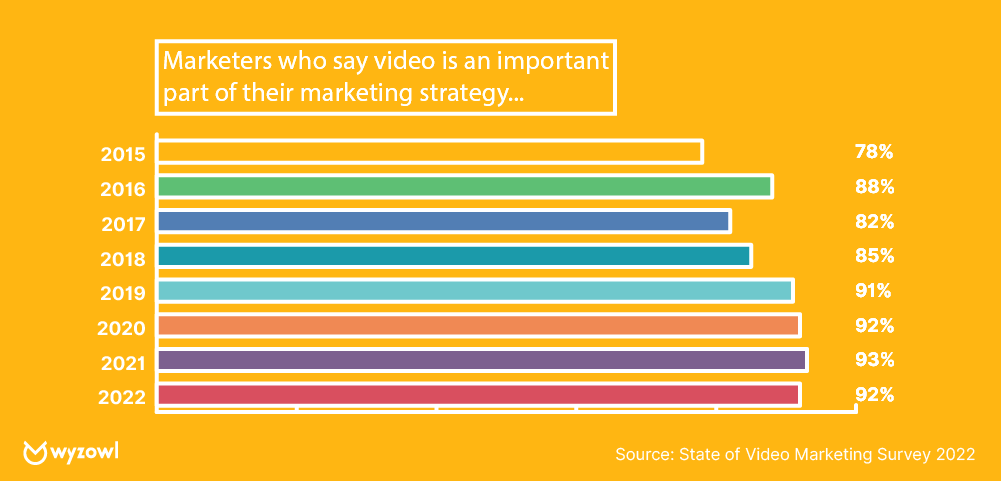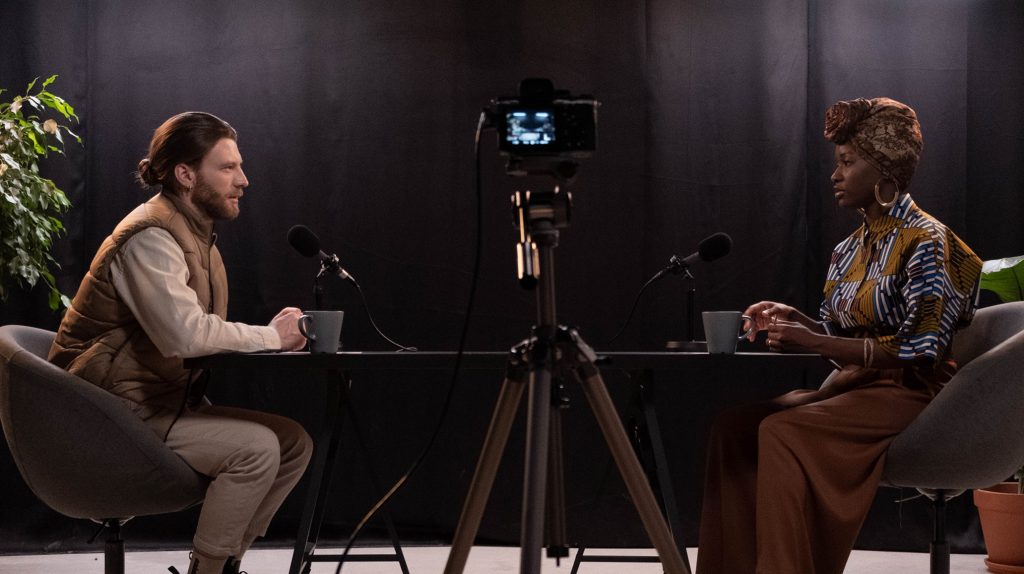If your marketing goal is to get the attention of busy consumers, make a real connection, and ultimately increase sales, then video is a highly effective medium for you. Putting effort into your video strategy will help your company be competitive, staying at the forefront of prospects’ minds.
According to LearnHub, video content is 1200% more successful than other content. Insivia found that viewers absorb 95% of the message while watching a video, making it a perfect strategy to create a memorable brand.
But WHY is it so powerful? And how can companies apply this strategy to every stage of the marketing process? Read on.
Video is:
- Shareable
- Memorable
- Entertaining
- Emotive
Video marketing now represents 35% of digital advertising marketing spend and upwards of 86% of businesses use video as a marketing tool.. It’s a norm in today’s marketing environment.
It can be shared on just about every platform:
- Youtube
- TikTok
- Snapchat
- Websites
Covid-19 also had a huge effect on its prevalence (Vidyard). You can visually see the increase from 2019 to 2020 when the pandemic hit:
Source: Vidyard
According to research by Hubspot, video marketing remains a key priority for marketers, with both usage and spend increasing in 2021. From 2018 to 2021, the amount of online videos people watch has doubled.

Source: Wyzowl
With video marketing becoming so prominent, companies not utilizing this powerful strategy are already 5 years behind. There are tons of ways to utilize video, whether you’re using it for brand awareness, promoting a specific product/service, or education.
It’s essential that companies leverage different types of video in the right way at each stage of the customer journey. Here are many ideas for each stage:
Awareness Phase
We can break the awareness phase into 2 types of prospects:
- People who don’t actively think about the problem your company solves
- People who are seeking a solution to the problem you solve
The great thing is that video helps you market towards both types. Unlike print/visual ads that need to be short and concise, with video you can agitate the problem and describe the solution in the same piece of content.
Here’s an example: Imagine an entrepreneur that’s used to managing their day-to-day schedule with a hand-written calendar. They’re relatively happy doing it that way, because it’s what they are used to. They may not realize all of the capabilities that a project management software could solve for them. A prospect like this would need videos describing the problem AND the solution. Are they being inefficient without even realizing it? How could they save time and organize their day better?
On the other hand, an entrepreneur who has established that they want to get more efficient at managing their schedule might be on the lookout for software to do so, and won’t need as much explanation about the problem. Yet still reiterating the problem to them (their inefficiency, loss of time, etc.) will make it even bigger of a priority for them to find a solution.
After agitating the problem, solving it in a visual way will always be more memorable than just writing about it or using images. The power of video as a marketing tool over print and text should not be understated.
So, if you’re a software company, show your UI. If you sell products that make their life better, show people using the product so the viewer can envision themselves doing it too. If you offer a service, show how easy/happy/efficient their life would be like during/after the service.
When viewers are drawn to the way you’re solving their problems, they’re well on their way to becoming paying customers. You get an extra bonus if you solve their problems and you’re witty, funny, or cutting-edge.
Keep in mind that during the early stages of the customer journey, you don’t want to overwhelm people with information. Take the time to determine the primary problem they are dealing with and the most attractive things about what you offer. Later on, you can get more specific.
When They Become a Marketing Qualified Lead (MQL)
After someone knows about your company and has expressed some level of interest (downloaded a lead generator, clicked on an email link, reached out, etc.), NOW is when you can get more specific with your video marketing. You can start showing more in-depth ways that you help them.
However, this doesn’t mean giving them an overwhelming video showing them every capability or benefit. It just means that now that you have their contact information, you can take your time to drip bite-sized videos to them, each with a more specific goal. Some of your videos may focus on capabilities/benefits in a more in-depth way, while others may be aimed at building trust.
You could produce these videos in the form of:
- Interviews
- User interface (UI) videos
- People using your products
- Animated explainers
- Entertainment/inspirational pieces
Because it’s so memorable, nurturing MQLs using video is the perfect way to help your company stay at the front of their mind. This brings us to the customer stage—after they make a purchase!
After They Become Customers
Even once you have turned an MQL into a paying customer, video can still be used to build the relationship.
During this phase, using video to educate the client could be very helpful. Is there a learning curve to what you offer? Can video help them learn in a much easier way? Most people would choose to watch a 2-minute tutorial video versus learning from written content, and the former is far better for long-term learning.
Build Trust in Every Stage: The Face Behind The Brand
Video marketing not only helps to bring awareness, engage viewers, and educate clients. They also build trust.

Gain trust and be more personable.
Internet is a relatively new concept in the grand scheme of our human existence, and we’re far more inclined to trust people we’ve met face-to-face.
Today’s highly skeptical consumers—who have become so good at tuning out the noise of advertisement—really need to trust a company before making a purchase or committing to something.
Video marketing allows companies to get a little bit more personal and start creating the necessary level of trust.
Depending on the type of video, prospects may get to see the face and voice behind the brand. They get a glimpse into that person’s life i.e. the environment around them, their mannerisms, their sense of humor, and their smile. Your company immediately becomes more human, which is really powerful. Even using the human voice as a narration for a video can create trust.
Showing the face or voice of employees or happy clients—such as through interviews—will create trust in every stage of the customer journey.
Different video settings influence how prospects get to know your company.
Companies in different industries will benefit from different video settings; this should be strategically planned out so you get the appropriate message across to viewers.

Filming on a stage-like set
Professional services companies like law firms, financial advisors, or banks can create a more corporate video environment to add an extra level of professionalism.
Personal brands or any company looking for a friendlier or even laid-back atmosphere could film in a home, outdoors, or in a creative/studio setting.
Strategically planning your environment depending on your industry influences viewers and helps them get to know your company in a desirable way.
There’s no better way to connect with your audience than seeing the “face behind the company”.
Video for Entertainment.
Not only can video be used as blatant advertisements. It can be far more subtle than that. For example… entertaining videos that also promote your brand.
Entertainment videos must be relatable to your target market. They need to be something your viewer will really connect with and want to share with others. If all of your videos look too much like commercials, you’re going to lose them eventually. So focus on having a healthy mix of both.
When I hear “entertainment video,” I immediately associate it with being something funny. But they don’t necessarily need to be funny. They could also be inspiring or educational—as long as they hold the attention of the viewer without being obviously promotional.

Create videos people want to watch in their off-time
Imagine a non-profit filming a commercial to get someone to donate. Then imagine a non-profit showing you all of the work they’re doing and how they’re helping people’s lives, and wait until the end to mention how you can get involved. The second video makes viewers feel uplifted and inspired to help out.
This is the type of content that gets re-shared and watched over and over again; it’s the type of video that’s going to stay relevant over time.
The Final Verdict: Video is King
Add video to your marketing tools and start building a more trustworthy brand, engaging viewers, and growing your revenue!
Here at De Lu Studios, we’re here to help you grow and be successful. We produce a wide variety of videos—from UI showcases to interviews to 3D animation. Reach out to us to learn more about what we do!




